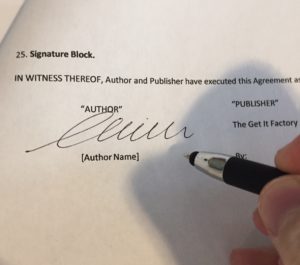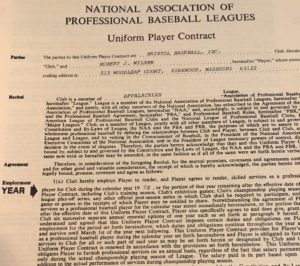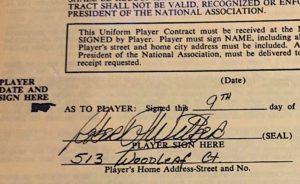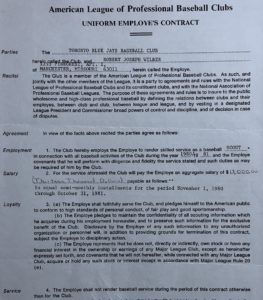It occurred to me in the last 24 hours that not that many people ever have the pleasure of signing a contract. Not any contract, like your mortgage, lease agreement, or car loan, that legally binds you to compensate the other party for products or services they are rendering. Instead, a contract that someone else offers to compensate you for the services and professional skills you will be providing. Landscapers, home renovators, builders, and some other trades routinely utilize contracts to guarantee they will be paid for the professional services they perform, but most people go through life on handshakes and verbal agreements. I’ve utilized those handshakes, of course, but I am fortunate to have signed more than a few contracts in the world of sports, and now I’m about to do so in the world of publishing. Such things are so rare, so beyond-belief rare, it’s always an honor and a thrill to sign at the bottom. I’m pretty sure I remember every one of them.
My publisher and I are now about 99% there on all the details outlined in our contract. The original version, sent to me this week, had a few tweaks that needed to be made and those are agreed upon and in the process now. There are lawyers involved, of course, so one could say reading through the document is a little “cumbersome” with all the legalese, but we’re getting it all sorted out so that the final agreement will be mutually beneficial for all involved.

This is my signature on the original publishing offer. It was a practice run just for this blog. It’s not binding because I won’t be sending it back. But, much like all of my baseball documents, it’s a contract to a dream. The dream to be a contracted author. To be appreciated and trusted to deliver a work that will not only be of professional quality but also entertaining. Sort of like being a baseball player. You have to provide professional quality play or the contract can be voided at any time in the minor leagues. No guarantees down there. And you have to entertain the people who are shelling out money to sit in the stands and either cheer for you or jeer you.
I’m extraordinarily fortunate to have earned this. It has never been an easy thing to accomplish in any version of the publishing world, but it’s tougher now than ever before. What I found (or what found me) is an entrepreneurial publisher who knows the key to finding the path to success is to work as a team. I’ll do the writing. Greg Halling will be there for me on the style editing. The Get It Factory (my publisher) will be there for other edits, formatting, graphics, covers, distribution, and marketing. It will be a team effort. We’ll all aim for professional quality and entertainment. I’ll make a little money, but that’s not the goal. The overriding goal is to tackle a new genre of writing and make it good (and professional) enough to entertain people who will shell out good money to buy it. Not much different than playing baseball in Bristol, or Painstville, or Lakeland, or Medford. You have to deliver.
With that in mind, I did something last night I hadn’t bothered to do yet. I finished a big, and important, chapter and wondered how many words I’ve written so far. That’s pretty key when it comes to page count, and page count will factor into how the book is formatted. Remember, the first draft of “Bats, Balls, & Burnouts” was so enormous it basically couldn’t be published. It would have been more than 900 pages. Tolstoy would’ve balked at that. So we cut, and we pruned, and we enlarged the book and minimized the margins. We employed every trick in the book. And we still ended up at 545 pages and a $49.95 paperback because I had no say in the price.
I think I’m about 60% done with the initial manuscript, and now that contracts are being exchanged I’m a bit on fire, in terms of writing. So after completing that chapter yesterday I used the “Word Count” tool on Google Docs. I’m at 105,000 or so. If I write at the same pace and rate, we’ll end up somewhere near 200,000 words. There will be editing and formatting, of course, so who knows what the final count will be, but the absolute mission is to keep the hardback version under $30. Later, when the paperback comes out, it will be under $20. Those are market driven prices, and they are price points that are proven to sell. The Get It Factory and I will work in conjunction to keep those prices where they need to be. This whole process is pretty energizing, to say the least, and it’s happening right when I need that push of energy. This “stay at home” quarantine impacts different people in different ways. I’m stir-crazy like everyone else, but I also find I slip into a sort of malaise easily, because the normal world is such a distant memory. Seeing this contract changed that. I have a very big reason to attack this every single day now. I sometimes find myself tweaking or writing at times like 6:00 a.m. or 12 midnight. Whenever a thought, idea, or motivator crosses my mind, I can open the laptop and work. The commute is easy. Sometimes it’s even as far as the living room sofa.

This is a photo of the first professional contract I ever signed. Actually, this is the top 1/3 of a lengthy two-sided legal document, but there’s my name and my home address on Woodleaf Court in Kirkwood, Mo. The way minor league contracts work, you sign with the team you are assigned to. So, even though I was the property of the Detroit Tigers, the contract was with the Bristol Tigers. When I was optioned to Paintsville, I signed a new contract. I still have that one, too.
As I outlined (hopefully well) in “Bats, Balls, & Burnouts” I signed this contract in the living room of the house I grew up in. It was just after the end of my senior (and final) season of college baseball, so I hadn’t actually lived in the Woodleaf house for four years, but college addresses are so transient it was best to send this to my parents’ home. Fitting, as well, I’d say. I spent two decades preparing to be a pro at that very house. Throwing tennis balls off the front of the house so I could turn and go back to catch them, leaping and backhanding them, for hours and days on end. Throwing a baseball against the concrete foundation to build up arm strength and accuracy, and practice catching the ground balls that came back to me. Our backyard was not exactly well groomed, so those caroms and bad hops were lessons to be learned.
When this contract arrived, I sat in the sunny living room with my mom (my dad was on the road). It was June 9th, 1978. I’d need to be in Bristol in just a couple of days. I wanted to sign it in a hurry, before anyone changed their minds, but I stopped and soaked it in. I was finally putting my name, and my signature, on a professional baseball contract. I had aspirations, but no firm dreams of playing in the big leagues. I just wanted to do the best I could and see how far I could get, playing against elite players at the next level.

As you can see here, from the bottom of the backside of the contract, my handwriting and autograph have “evolved” greatly over the years. This was all I had then, in terms of a signature. According to the contract, I had to sign my full name and middle initial, and I wasn’t used to doing that, so it was what it was. The circle over the “i” in Wilber was something I absorbed from my dad. He signed many thousands of autographs and the baseball cards and requests were still showing up in the mail when he died. They are all over eBay to this day. He almost always put the circle over the “i” instead of a dot. As you can see in the top photo, I’ve made my signature more efficient these days. There is an “R” to begin it, and then swoops to represent all the letters in “Wilber.” I always go with a dot over what would be the “i” now. It’s just easier. I even put the dot on it when signing a screen at the check-out counter. Habits… They die hard.
After my playing days were over, and I’d signed new annual contracts with Bristol, Lakeland, Paintsville, and Medford (where I got a huge bump up to $700 per month in salary!) the final document I received from the Oakland A’s was a form that contained a wide variety of ways your contract could be assigned or dispensed with. It was the “Disposition of Contract” form, in triplicate. The third box down on that form, which was checked, was next to the line “Player has been released outright from the contract.” There was a name for that in the baseball world. It was known as “getting your number three box checked.” I got my number three box checked twice. Lucky me. I actually pinned those two forms on the inside of my bedroom door at the last apartment in which Lance and I lived, in North St. Louis.
So with that, I needed a job. And the Toronto Blue Jays came calling. I was hired, probably against a lot of people’s better judgement, and I signed a different kind of contract. It was blue, instead of tan, and the actual title or job had to be entered into a blank space. Front office people, staffers, coaches, and scouts all signed these. My first one, which I no longer seem to have, was for the amazing sum of $8,600 for the year 1980. Seriously. How on Earth did I live on that? Plus, I had to get my first credit card just to be on the road. My mom co-signed for me at Commerce Bank in Kirkwood. That original MasterCard had a $500 credit limit. Yep. Again, how did I do that? I know this: You had to want to. It wasn’t the sort of job you took just because you needed work.
To be fair, we were on full expense accounts. So, the more you were on the road working, the fewer necessities you had to personally pay for. Meals, lodging, and miles on your personal car were all covered, and the per-mile car payment included depreciation, so it was always for a lot more than the gas it took to make those trips. Somehow, some way, I survived.

This is my second contract with the Blue Jays. I got bumped up all the way to the unheard of amount of $13,000 for 1981. I also had to move to Fresno, Calif. that year, but all those expenses were covered as well. I remember still eating a lot of tuna sandwiches and beef tacos, but I got through it and did the best I could covering the central part of the state.
By 1982, the Jays reshuffled assignments again and sent me back to St. Louis. Incredibly, I believe that third contract was for about $19,000 and I covered as many as eight midwestern states. My fourth and final contract with Toronto got me up to where most of my colleagues were. It was for $21,000 and I thought I was rich.
The job was hard. The travel was incredibly backbreaking. And the challenges could be enormous, thanks to the Major League draft which allowed all the teams to grab players round by round, often leaving a hard-working scout like me with nothing but “Good work, Bob. Sorry we didn’t get any of your guys” at the end of a long string of months on the road.
The rewards could be great as well. Changing the lives of guys like Keith Gilliam and Jim Gott, by spotting them and going to bat for them with the Blue Jays, and being persistent enough to sign one to a rookie contract (in Gilliam’s case) after seeing him pitch for Austin Peay State, or select the other No. 1 in the Rule 5 draft from the Cardinals (in Gott’s case) after seeing him pitch in Mexico. Sometimes, the big fish got away, and I wrote about that extensively in “Bats, Balls, & Burnouts” too. The names Mike Henneman and Joe Magrane come to mind. They did great things in the big leagues, but for other teams.
In racing, our team certainly signed contracts with our sponsors every year, but as the manager and PR rep my signature was never required, whether the contract was with CSK Auto or Levi, Ray & Shoup. I was there for most of those signings, but just as a spectator. I’ll never forget the first multi-year deal we signed with CSK. Once the signatures were in place, Del, Chuck, and I looked at each other and smiled. It was the first time any of us had ever had the luxury of knowing we had jobs for more than a year. A lot of hard work went into those. It was different with Tim Wilkerson. Yes, we had to perform professionally and make the LRS sponsorship a good business decision for them, but over the years Tim and Dick Levi had built up a great deal of trust with one another, and the Funny Car was a major part of their annual marketing plan. Although each contract was for just one year there, it’s still vibrant and renewed once again, 20+ years later. The Team Wilk partnership with LRS is one of the best, most solid, and most mutually beneficial deals in the sport. It was an honor to be a part of both of those programs, CSK and LRS, for two amazing decades. “Changed my life forever” is a mild way to put it.
So here I am. Almost 64 years old and about to sign my “swoopy” signature at the bottom of another contract. It’s on me to deliver. I have to create, out of thin air, a book people will want to buy, and then enjoy once they do. It’s as much of a challenge as hitting a mid-90s fastball, or deciding which of those kids out on that field can really play and which can’t. I’m up for it.
Favor time, as always: If you just finished this and liked it even an official “smidgen” please click on the “Like” button at the top. And then read it again. There will be a test tomorrow.
See you next week. Time to do more writing.
Bob Wilber, at your service and contractually obligated.